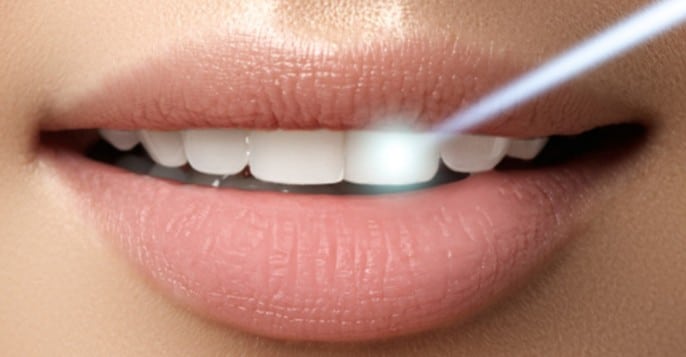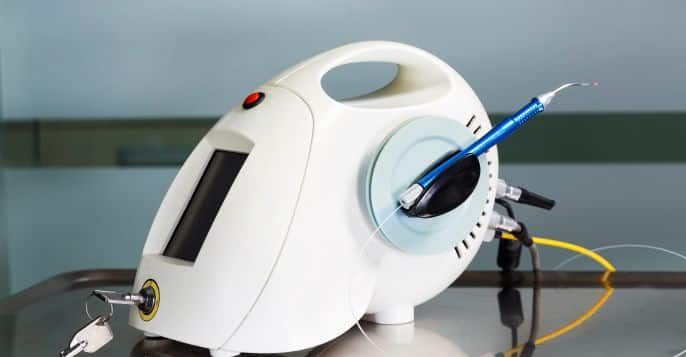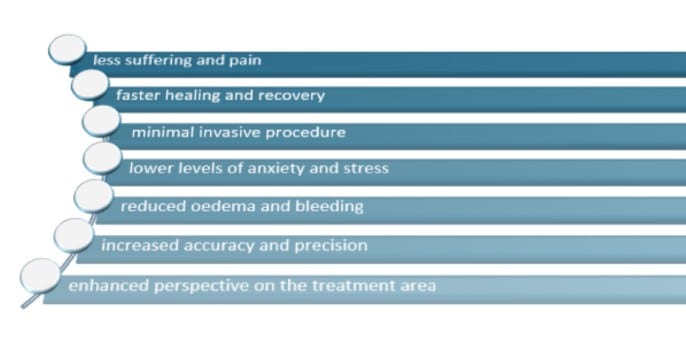INTRODUCTION

Dental treatments are often avoided due to fear and pain. However, the benefits of laser dentistry have transformed dental treatment with more accurate, secure, and pleasant operations thanks to technological breakthroughs. Benefits of laser dentistry dental care change aims to improve oral health and patient quality of life. Dental lasers are replacing conventional equipment because many people fear the dentist.
Our dental clinic uses laser dentistry to improve patient treatment. We enjoy improving patient quality of life and dental health. We use lasers instead of conventional dental equipment since many folks are afraid of them.
WHAT ARE DENTAL LASERS?

LASER is Light Amplification by Stimulated Emission of Radiation. In conclusion, lasers use light energy to create a narrow beam that cuts through materials. Diamonds, heavy metal, and delicate tissue can be sliced by lasers.
Laser beams are thin and concentrated for precision. Waves of light are measured. Researchers measure wavelengths in nanometres. Visual light is 400–700 nm. Infrared light, 700 nm to 1 mm, is invisible to the human eye.
HOW CAN LASERS IMPROVE YOUR EXPERIENCE?
People fear the dentist because of the drill’s noise, vibration, heat, and smell. Although the dental drill has been successful, many people still have anxiety about the dentist. If you’re one of them, don’t worry. Because lasers are quieter and produce less heat and vibration than drills, we employ them. Many of our patients feel so much better after therapy that they don’t need anaesthesia or painkillers.
types of lasers in dentistry
Generally classified into two types: soft tissue lasers and hard tissue lasers. Their wavelength is greatly absorbed by hydroxyapatite, the calcium phosphate salt in teeth, and water, making hard tissue lasers better at slicing tooth structure. Cutting bone and teeth precisely is these lasers’ major use. Teeth “prepping” or “shaping” for composite bonding, minor tooth structure removal, and dental filling repair.
Soft Tissue Lasers: Because water and haemoglobin in the blood absorb light, soft tissue lasers penetrate soft tissues better and close blood vessels and nerve terminals. Patients report almost no pain after surgery because soft tissue lasers speed up recovery.
WHAT PATIENTS CAN GET BENEFITS OF LASER DENTISTRY

- Less suffering and pain: Benefits of laser dentistry is beneficial since it is less painful than drilling. Lasers let dentists treat more precisely and without hurting neighbouring healthy tissues. Most patients experience little to no pain during or after laser treatments, eliminating the need for anaesthesia. A laser doesn’t hurt or make a noise like a dentist’s drill. Laser dentistry often makes dental visits less stressful.
- Faster healing and recovery: Laser treatments speed up recovery and reduce oedema and bleeding. Due to decreased inflammation, you won’t feel throbbing pain or sensitivity for days after treatment. Patients can usually resume their diet and dental care promptly. Lasers also sterilise the region, reducing bacterial infections. Laser dentistry lets you leave the dentist quickly.
- Minimal invasive procedure: Lasers’ accuracy and precision allow dentists to perform various minimally invasive treatments. They may fix issues with a little incision instead than removing a lot of tooth and gum tissue. Lasers minimise nerve and root damage during gum disease and root canal procedures. Non-invasive laser dentistry decreases problems and speeds recovery. Problems may be fixed without harming healthy tissue.
- Lower levels of anxiety and stress: Benefits of Laser dentistry may help dental anxiety sufferers relax due to its painlessness. Just thinking about their dentist looming over them and noisily drilling their teeth would make anybody uneasy. Lasers eradicate deterioration gently and quietly with a clicking noise. Anticipating pain increases relaxation, not blood pressure. Laser dentistry’s relaxed atmosphere makes dental visits more pleasant.
- Reduced oedema and bleeding: Lasers’ accuracy protects oral soft tissues during treatments. Traditional instruments may accidentally cut or damage adjacent tissue, including gums. This may cause surgical bleeding, post-op pain, and oedema. Laser radiation can target and eradicate ill tissue without affecting good tissue. Surgery reduces bleeding, oedema, and healing time.
- Increased accuracy and precision: Laser technology allows dentists to perform difficult procedures with precision. Tiny intensity and thin precision tips enable detailed treatments that portable tools cannot. Lasers let dentists reach hard-to-reach regions and remove unhealthy tissue without harming healthy tissue. Lasers are accurate to the millimetre for complex root canal operations and cavity exams.
- Enhanced perspective on the treatment area: Laser technology’s built-in lighting and magnification allow dentists to see inside your mouth better than ever. Due to improved visualisation, dentists can execute more precise, regulated procedures and spot issues that are not obvious in the daytime. They evaluate tissues, check cracks for degeneration, and perform sophisticated root canal treatments. Visibility improves dental work overall.
PROCEDURES THAT ARE TREATED USING LASER DENTISTRY
- Diagnosing and treating caries: Low-intensity dental lasers can detect cavities early by measuring tooth decay byproducts. Portable, battery-powered Diagnodent diode lasers detect dental cavities. Active caries glows at 655 nm. Measured fluorescence is related to lesion size and direction. Intraoperative laser caries detection can verify minimally restorative preparations for total decay removal.
Dental restorative procedures: - Accurate ablation enables the performance of less invasive procedures
- Elimination of the smear layer
- Sterilisation of preparations
- Minimises the auditory, thermal, and oscillatory disturbances caused by high
- velocity rotational equipment.
- Decreased need for local anaesthesia
- Selective caries removal is performed because carious dentin has a greater water
- content and softer consistency.
- Periodontal pocket therapy: All four basic dental laser wavelengths treat periodontal disease. Sulcular debridement with diodes, Er: YAG, Nd: YAG, and CO2 devices from various manufacturers have FDA permission to enhance gingival index, bleeding index, probe depth, attachment level, and tooth mobility by removing diseased or inflamed soft tissue in the periodontal pocket. Erbium lasers scale, root plan, cleanse pockets, and replace scalpels for incisions.
- Oral diagnosis – Biopsy: Biopsies can be done safely with any dental laser wavelength. Topical compounded anaesthetic can eliminate smaller lesions. Lasers give high haemostasis and little stress, therefore sutures are rarely needed. Excised lesions must be microscopic and diagnosed by an oral pathologist. The dentist should note the laser type used since a “laser artefact.” tissue effect often forms around the incision. Laser thermal effects and settings affect the artefact.
- Gingivectomy: The most frequent dental laser operation is gingivectomy. All laser wavelengths may accurately incise gingiva for restorative, aesthetic, and periodontal purposes. Lasers may reshape gums to reveal healthy tooth structure and enhance gummy smiles. Postoperatively, individuals recover quickly and seldom require periodontal packing or sutures.
- Frenectomy: Children with speech impairments and newborns with restricted tongue movement who cannot nurse might consider a laser frenectomy.
- Crown lengthening: Crown lengthening uses soft tissue and hard tissue lasers to reshape gums and bones for better teeth.
- Oral surgery: Extractions using less-traumatic flaps and bone removal, Alveoloplasty, Incision and Drainage, Operculectomies, Peri-implantitis Treatment, Pre-Prosthetic Ridge Preparation/Hyperplasic Tissue Reduction, Frenectomies, Tuberosity Reductions, Vestibuloplasty.
- Tooth sensitivity: Lasers may seal root tubules that cause hot and cold tooth sensitivity.
- Nerve regeneration: Photo-bio-modulation regenerates neurones, blood vessels, and scars.
- Teeth whitening (bleaching): Teeth whitening is accelerated by low-intensity soft tissue dental lasers.
- Sleep apnea (sleeping disorders/snoring): Laser-assisted uvuloplasty may remodel the throat and treat sleep apnoea breathing issues.
- Temporomandibular joint treatment: Utilising dental laser therapy may promptly alleviate discomfort and inflammation in the temporomandibular jaw joint.
- Laser depigmentation: A laser removes the gums’ top layer, which contains the most melanin, the black pigment. Pink gums are appealing. Laser gingival depigmentation is safe, comfortable, and effective. It often reduces pigmentation without periodontal/gingival dressing. It also eases surface protein coagulum discomfort. The operation field can be clean and dry for consistent outcomes.
- Root canal treatment: Thanks to its intensity and wavelength, the laser may destroy microorganisms, remove debris, and smear the root canal walls after biomechanical instrumentation.
FAQ (Frequently Asked Questions)
Q, 1. Are dental procedures performed with lasers safe?
Ans. Laser dentistry is safe when done by a trained professional. Dental lasers allow dentists to meticulously remove cavities and perform other procedures with a highly concentrated light beam. This means they won’t damage healthy tissues and teeth.
Q, 2. Which treatments are possible using dental lasers?
Ans. Numerous dental care operations, such as cavity identification, gum and tooth contouring, fillings, root canals, teeth whitening, biopsy collection, and growth or lesion eradication, may be accomplished using lasers.
Q, 3. Do dental laser procedures hurt?
Ans. When receiving laser dentistry treatments, the majority of patients experience little to no discomfort. In comparison to conventional dental instruments, lasers are significantly less annoying since they don’t produce painful pressure, vibration, or loud drilling sounds.
Q, 4. Is the cost of laser dentistry higher?
Ans. Laser dentistry can be more expensive than traditional methods. In most cases, the higher cost is justified by less pain, faster recovery, precise treatments, and minimally intrusive methods. As laser technology advances and becomes more affordable, its cost is falling.
CONCLUSION
Although they can’t treat every dental health problem, lasers are a significant improvement in patient comfort, accuracy, and recuperation. Benefits of Laser dentistry has several advantages for patients over conventional procedures, including being more precise and requiring less physical intervention.
Laser technology has the potential to alter your mind if you detest seeing the dentist because it hurts. You may take care of your teeth without experiencing severe pain or suffering thanks to laser treatments, which need minimal drilling, bleeding, swelling, and recuperation time.






